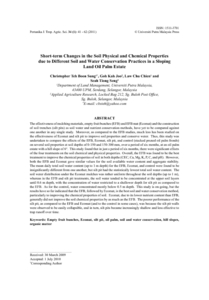Citation
Teh, Christopher Boon Sung and Goh, Kah Joo and Law, Chu Chien and Seah, Tiong Seng
(2011)
Short-term changes in the soil physical and chemical properties due to different soil and water conservation practices in a sloping land oil palm estate.
Pertanika Journal of Tropical Agricultural Science, 34 (1).
pp. 41-62.
ISSN 1511-3701; ESSN: 2231-8542
Abstract
The effectiveness of mulching materials, empty fruit bunches (EFB) and EFB mat (Ecomat) and the construction of soil trenches (silt pits) as soil water and nutrient conservation methods, have yet to be compared against one another in any single study. Moreover, as compared to the EFB studies, much less has been studied on the effectiveness of Ecomat and silt pit to improve soil properties and conserve water. Thus, this study was undertaken to compare the effects of the EFB, Ecomat, silt pit, and control (stacked pruned oil palm fronds) on several soil properties at soil depths of 0-150 and 150-300 mm, over a period of six months, at an oil palm estate with a hill slope of 6°. This study found that in just a period of six months, there were significant effects of the four treatments on the soil chemical and physical properties. Overall, the EFB was found to be the best treatment to improve the chemical properties of soil in both depths (CEC, Ca, Mg, K, P, C, and pH). However, both the EFB and Ecomat gave similar values for the soil available water content and aggregate stability. The mean daily total soil water content (up to 1 m depth) for the EFB, Ecomat, and control were found to be insignificantly different from one another, but silt pit had the statistically lowest total soil water content. The soil water distribution under the Ecomat mulches was rather uniform throughout the soil depths (up to 1 m), whereas in the EFB and silt pit treatments, the soil water tended to be concentrated at the upper soil layers until 0.6 m depth, with the concentration of water restricted to a shallower depth for silt pit as compared to the EFB. As for the control, water concentrated mostly below 0.5 m depth. This study is on-going, but the results have so far indicated that the EFB, followed by Ecomat, is the best soil and water conservation method, particularly to improving the chemical properties of soil. Ecomat, due to its lower nutrient content than EFB, generally did not improve the soil chemical properties by as much as the EFB. The poorer performance of the silt pit, as compared to the EFB and Ecomat (and to the control in some cases), was because the silt pit walls were observed to be easily collapsible, and in turn, silt pits became increasingly shallow and less effective to trap runoff over time.
Download File
![[img]](http://psasir.upm.edu.my/11192/1.hassmallThumbnailVersion/Short-term%20Changes%20in%20the%20Soil%20Physical%20and%20Chemical%20Properties%20due%20to%20Different%20Soil%20and%20Water%20Conservation%20Practices%20in%20a%20Sloping%20Land%20Oil%20Palm%20Estate.pdf)  Preview |
|
PDF
Short-term Changes in the Soil Physical and Chemical Properties due to Different Soil and Water Conservation Practices in a Sloping Land Oil Palm Estate.pdf
Download (1MB)
| Preview
|
|
Additional Metadata
Actions (login required)
 |
View Item |

